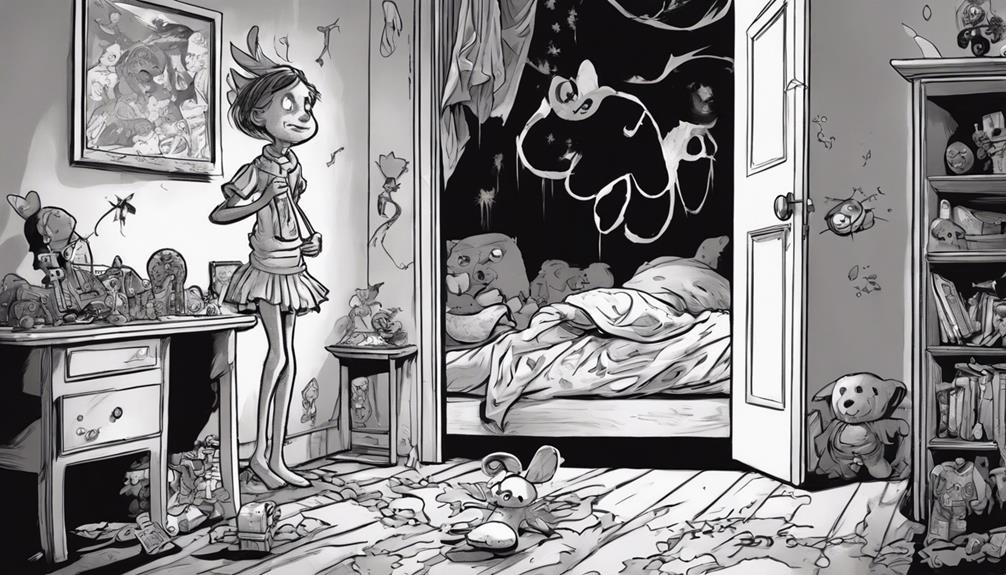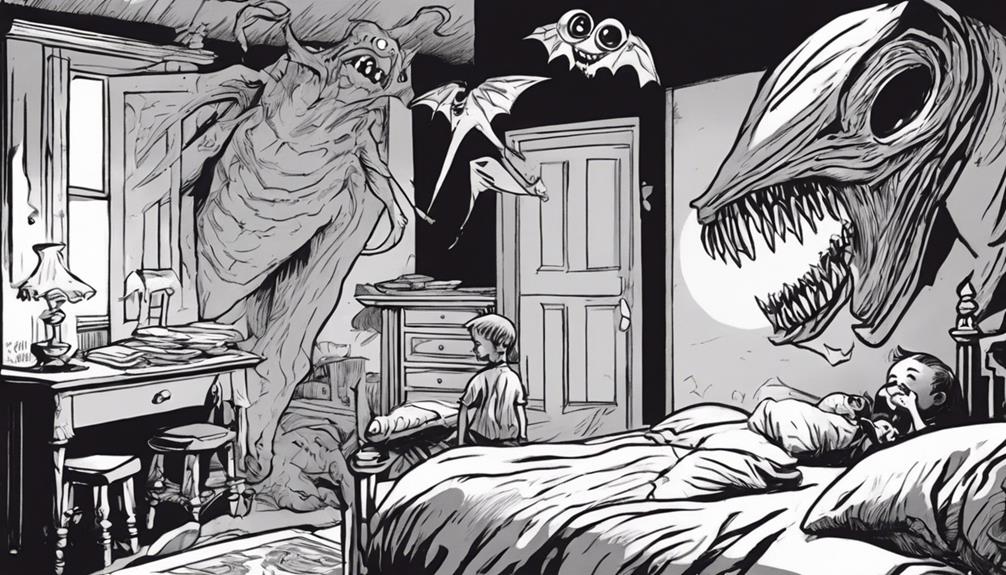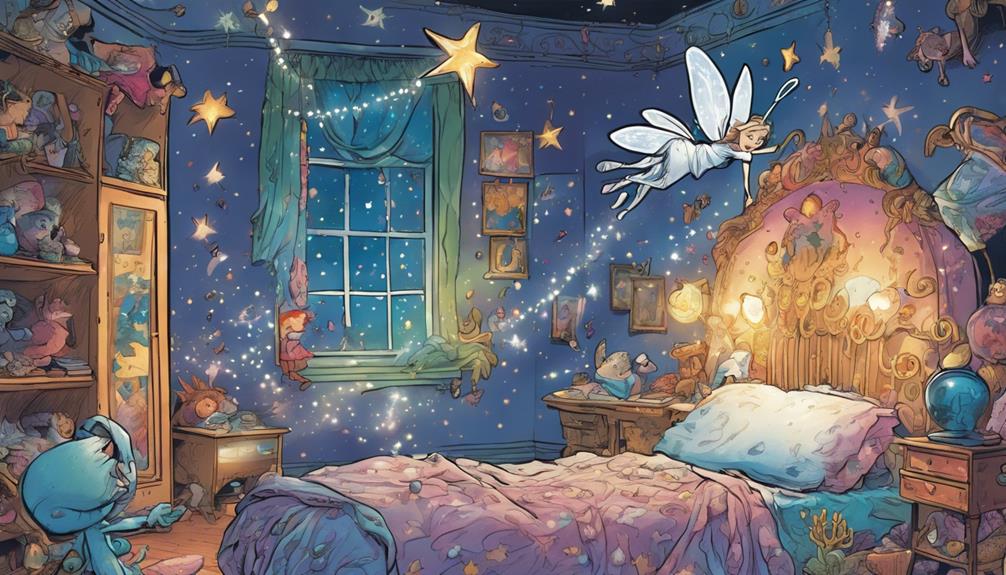The Tooth Fairy's biggest fears revolve around losing the magic of childhood wonder and being forgotten. She thrives on kids believing in her enchanting rituals, but as skepticism grows in children aged 7 to 8, her existence feels threatened. If parents don't actively engage in the myth, it fades away, taking with it the joy and excitement of losing a tooth. The rise of digital distractions also worries her, as fewer children participate in traditional customs. These shifts might diminish her role in childhood. There's so much more to discover about her journey and challenges, so keep exploring!
Key Takeaways
- The Tooth Fairy fears the loss of childhood wonder as children's belief diminishes, impacting imagination and cognitive development.
- Growing skepticism among children, fueled by media and economic factors, threatens the Tooth Fairy's existence in their minds.
- Parental beliefs and involvement significantly influence children's emotions and perceptions about tooth loss and the Tooth Fairy myth.
- Cultural shifts and modern parenting adaptations, like digital apps, risk overshadowing traditional Tooth Fairy rituals and memories.
The Loss of Childhood Wonder

The Tooth Fairy fears that as children lose their sense of wonder, they also lose the magic and innocence that make childhood so special. During those early years, when you believe in magical figures like the Tooth Fairy, your imagination flourishes. This magical thinking, prevalent in kids aged 3 to 8, is essential for your cognitive development. It helps you cope with the unknown, allowing you to explore and create without limits.
However, as you approach ages 7 to 8, that belief begins to wane. This change signifies more than just a simple questioning; it marks the end of an imaginative phase that's important for fostering creativity and emotional security. When you stop believing in the Tooth Fairy, you're not just letting go of a whimsical figure; you're also losing a piece of that childhood wonder.
Cultural narratives surrounding the Tooth Fairy highlight the importance of maintaining this wonder. By cherishing these magical rituals, you can keep the spirit of childhood alive, ensuring that the innocence and joy of those early years don't fade away too quickly.
Embrace the magic while you can; it shapes who you're and who you'll become.
Growing Skepticism Among Children

Increasingly, children around the ages of 7 to 8 start to question the Tooth Fairy's existence as they navigate their growing skepticism.
As they mature, you may notice them piecing together clues that challenge the fairy's reality. Economic factors, like the average payment of $5.84 per tooth in the U.S. in 2024, can raise eyebrows when they see friends receiving different amounts or sharing stories that don't add up.
Cultural exposure also plays a role. If they hear about traditions like the Latin American mouse exchange, it can confuse them further, leading to more questions about the Tooth Fairy.
Additionally, media representation in movies and books helps them differentiate between fantasy and reality, fueling this skepticism.
As your child develops cognitively, they become more adept at negotiating beliefs. They start to realize that some stories are just that—stories.
This shift in understanding can be overwhelming for you, as the Tooth Fairy's magic begins to fade in your child's eyes, marking a significant change in their childhood.
Impact of Parental Beliefs

Your beliefs about the Tooth Fairy can greatly influence how your child feels about her.
When you actively engage in traditions and share stories, you shape their perceptions and emotional responses.
Open communication can either ease their fears or amplify them, depending on how you approach the myth.
Parental Influence on Fears
Parental beliefs about the Tooth Fairy shape how kids perceive and react to the myth, influencing their fears and emotions surrounding tooth loss. When you embrace the Tooth Fairy with enthusiasm, your child feels secure and excited. However, if you express skepticism, it can lead to confusion and fear. Here's how parental influence plays an essential role:
- Positive Reinforcement: Actively participating in Tooth Fairy rituals, like leaving notes or coins, helps your child feel the magic of the experience.
- Emotional Support: Your belief in the Tooth Fairy provides comfort, helping your child navigate the changes that come with losing teeth.
- Setting Expectations: By discussing the Tooth Fairy openly, you set a tone that can either alleviate or heighten fears about losing a tooth.
- Cultural Pressure: Worries about maintaining the myth can create anxiety for you, which may inadvertently affect your child's feelings about the Tooth Fairy and tooth loss.
Ultimately, your attitude and involvement directly impact how your child handles this pivotal moment, shaping their emotional responses and fears.
Traditions Shaping Perceptions
Traditions surrounding the Tooth Fairy often reflect parents' beliefs, influencing how children perceive this mythical figure and their feelings about losing teeth.
When you emphasize the Tooth Fairy's kindness, children may feel excited and look forward to losing their teeth. However, if you share cautionary tales, it could instill fear, making them anxious about the process. The way you engage with this tradition plays an essential role in shaping your child's emotional development and their understanding of fantasy versus reality.
The monetary rewards you choose to give for each tooth can also impact your child's views on materialism and value. If you offer a generous sum, they might associate losing teeth with financial gain, while smaller amounts could promote a different perspective.
Cultural differences further enrich these traditions; for instance, in some Latin cultures, a mouse replaces the Tooth Fairy, illustrating how familial and societal beliefs shape children's understanding of these figures.
Ultimately, your approach to the Tooth Fairy tradition molds your child's feelings about their teeth and the magic surrounding them, highlighting the significant impact of parental beliefs.
Communication About Beliefs
Communication about beliefs shapes how children perceive the Tooth Fairy, influencing their understanding of fantasy and reality. When you share stories and engage in rituals, you play a pivotal role in how your child navigates this magical domain.
Here are four key ways your beliefs impact their perception:
- Myth Perpetuation: Parents who actively engage in the Tooth Fairy myth often reinforce their child's belief in fantasy, creating a sense of wonder.
- Negotiation of Beliefs: Research shows children negotiate their beliefs based on your involvement. When you openly discuss these figures, they feel empowered in their understanding.
- Emotional Investment: Your desire to protect their innocence can lead to deeper emotional ties to the Tooth Fairy, affecting how they view growing up.
- Cultural Pressures: Societal narratives may compel you to uphold the myth, impacting how you communicate about the Tooth Fairy's role in their development.
When you talk openly about these beliefs, you help ease their anxieties and fears, making the shift from fantasy to reality smoother.
This communication fosters trust and understanding, ensuring they feel secure in their imaginative explorations.
Cultural Shifts and Traditions

As you explore the Tooth Fairy tradition, you'll notice how it's changed over time, adapting to modern values and beliefs.
Different cultures add unique twists, from Ratoncito Pérez in Spain to Toppolino in Italy, showcasing regional customs.
Plus, today's parents often personalize the experience, creating lasting memories that reflect their family's style.
Evolving Tooth Fairy Narratives
The Tooth Fairy's narrative has transformed over centuries, reflecting cultural shifts and diverse traditions that shape children's experiences of growing up. You might be surprised to learn how this myth has evolved and adapted through various influences. Here are some key highlights:
- Origins in Norse Traditions: The Tooth Fairy traces back to the 10th century, where parents collected children's teeth for blessings before battles, representing early cultural practices surrounding tooth loss.
- Literary Milestones: In 1927, Esther Watkins Arnold's play introduced the Tooth Fairy to print, marking a significant moment in American culture.
- Cultural Variations: Different cultures have their own versions of the Tooth Fairy, like Ratoncito Pérez in Spanish-speaking countries and Toppolino in Italy, showcasing unique traditions that symbolize childhood innocence.
- Economic Influences: The average exchange for a lost tooth in the U.S. reached $5.84 in 2024, reflecting economic shifts and parental influences on the tradition.
As you see, the Tooth Fairy continues to evolve, adapting to modern values while maintaining its core message of childhood wonder.
Global Variations in Customs
Cultural variations in tooth customs reveal how different societies celebrate the milestone of losing a tooth, each adding their unique twist to this cherished childhood experience.
In many Latin cultures, the Tooth Fairy is replaced by Ratoncito Pérez, a little mouse that exchanges teeth for money or gifts, showcasing how traditions adapt to local customs. Meanwhile, in Japan, instead of placing teeth under pillows, children often throw their lost teeth onto roofs or bury them to encourage straight growth, highlighting distinctive practices.
The French tradition introduces you to La Petite Souris, another mouse who collects teeth, blending fairy tales with animal mythology. In some Middle Eastern countries, children toss their teeth into the sky, believing that this act will guarantee strong and healthy adult teeth.
These diverse customs emphasize the universal significance of tooth loss, celebrating childhood milestones through various practices. Whether it's a mouse or a fairy, or symbolic acts of good luck, these traditions reflect the rich cultural tapestry surrounding this common childhood experience.
Ultimately, the Tooth Fairy might find herself a bit scared of all these variations, realizing her reign isn't as universal as she once thought!
Modern Parenting Adaptations
Modern parenting has embraced innovative ways to adapt the Tooth Fairy tradition, incorporating technology and personalized touches to enhance the experience for children. Here are some popular adaptations you might consider:
- Digital Apps: Many families now use apps and websites that allow kids to track their lost teeth and receive virtual notes from the Tooth Fairy, making the experience more interactive.
- Personalized Gifts: Instead of just cash, parents often leave thoughtful notes or small gifts from the Tooth Fairy, which adds a unique touch and creates lasting memories.
- Alternative Tooth Locations: To address children's fears, some parents opt to leave teeth on dinner tables instead of under pillows, making the tradition feel less intimidating.
- Cultural Blending: Families are increasingly blending the Tooth Fairy with other cultural figures, like Ratoncito Pérez, promoting inclusivity and enriching children's understanding of various myths.
Evolution of Tooth Fairy Practices

Over time, Tooth Fairy practices have transformed from ancient customs of burying baby teeth for protection to today's playful exchanges of teeth for money and gifts. Historically, people believed that burying baby teeth safeguarded children from harm, reflecting a deep-rooted cultural significance. By the early 20th century, the Tooth Fairy concept gained popularity in the U.S., with a notable mention in a 1927 play marking its entry into American folklore.
Today, when a child loses a tooth, they enthusiastically place it under their pillow, anticipating the Tooth Fairy's visit. You might find that modern practices often include leaving personalized notes or small gifts alongside the cash, creating a memorable experience. In 2024, the average payment for a lost tooth in the U.S. reached about $5.84, influenced by inflation and peer expectations.
Interestingly, cultural variations exist globally, such as the mouse tradition in Latin cultures, showcasing how different societies interpret this rite of passage. These evolving practices highlight how the Tooth Fairy adapts to changing values while maintaining the magic surrounding the loss of baby teeth.
Fear of Being Forgotten

As children grow older and become more aware of the commercial aspects of childhood myths, the Tooth Fairy fears she might be forgotten altogether. With the average age of belief dropping to around 7-8 years, she worries her legacy could fade. Here are some reasons for her concern:
- Cultural shifts may lead children to lose the magic of believing in the Tooth.
- The rise of digital apps could replace traditional tooth exchange rituals.
- Parents focus more on the commercial side, overshadowing her role.
- An estimated 300,000 teeth collected nightly could dwindle if fewer kids participate.
The Tooth Fairy cherishes the joy of collecting lost teeth and leaving surprises. Each visit is a small reminder of childhood wonder.
With fewer children believing in the Tooth, her relevance hangs in the balance. She fears that as childhood traditions evolve, she may become a distant memory, replaced by modern distractions.
The Tooth Fairy hopes that families will continue to embrace the magic of her visits, ensuring that the joy of losing a tooth remains a cherished moment for generations to come.
Balancing Magic and Reality

The Tooth Fairy skillfully navigates the delicate line between childhood magic and the inevitable reality of growing up, ensuring that losing a tooth becomes a memorable and positive experience.
By addressing children's fears surrounding tooth loss, she transforms anxiety into excitement through rituals and rewards. This magical figure helps kids cope with the emotional aspects of losing a tooth, framing it as a rite of passage rather than something to dread.
Around ages 7 to 8, children typically begin to shift from believing in the Tooth Fairy to understanding reality. This change highlights the importance of balancing magic and reality in their development. Parents play a significant role in this process, fostering the myth while preparing kids for life's challenges.
The Tooth Fairy's existence as a cultural icon reflects society's values, combining fantasy with genuine emotional support. By encouraging children to embrace the joy of losing a tooth, she cultivates resilience and positivity.
Ultimately, the Tooth Fairy's ability to balance magic and reality not only enriches childhood but also lays a foundation for healthy cognitive and emotional growth as children mature.
Frequently Asked Questions
What Are the Tooth Fairy's Superpowers?
The Tooth Fairy's superpowers include invisibility for stealthy visits, flight for quick travel, telepathic communication with kids, transforming teeth into gifts or currency, and a charm that brings good luck to those she visits.
What Is the Tooth Fairy's Favorite Animal?
You might think the Tooth Fairy's favorite animal is a rabbit. Rabbits symbolize new beginnings and childhood, perfectly reflecting her nurturing spirit as she comforts kids during the change of losing their baby teeth.
Conclusion
In the end, the Tooth Fairy's biggest fears mirror our own: the fading magic of childhood and the inevitable march of reality. The tooth fairy’s transformations from a mystical pixie to a symbol of nostalgia parallel our own evolution from innocent children to jaded adults. As we grapple with our own fears of growing up and losing the enchantment of our youth, we can find solace in the fact that the tooth fairy, too, experiences similar anxieties. In the end, perhaps we are not so different from this elusive figure after all.
As kids grow skeptical and traditions shift, she worries about being forgotten, like a once-beloved story gathering dust on a shelf.
Balancing wonder with the truth is a delicate dance, but it's crucial to nurture that spark of imagination.
After all, a little magic can brighten even the most mundane moments of life.









